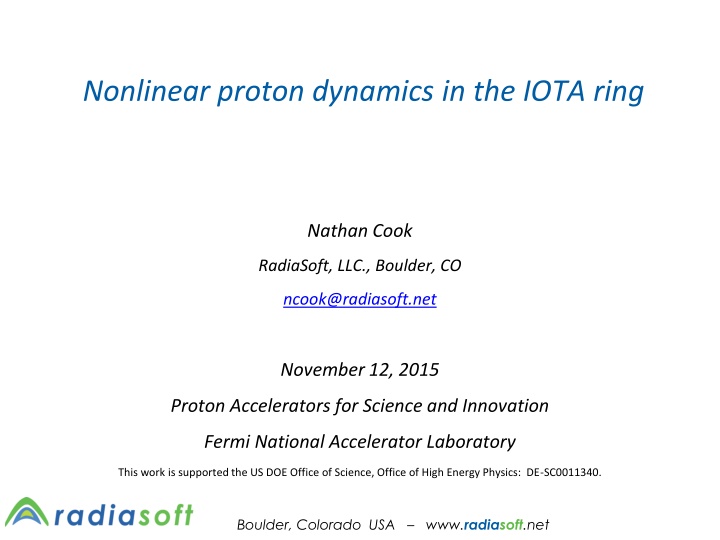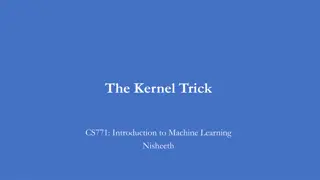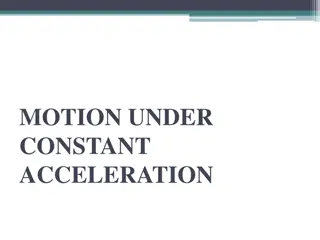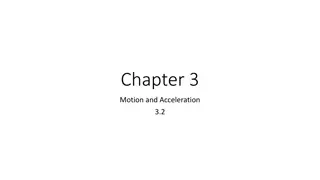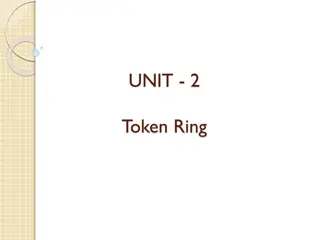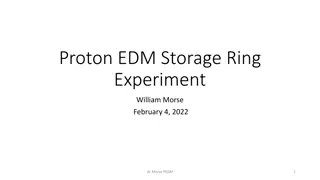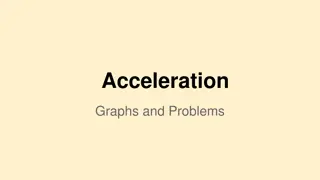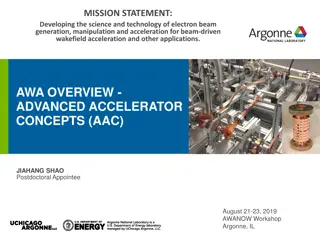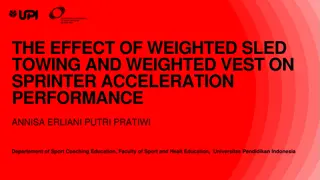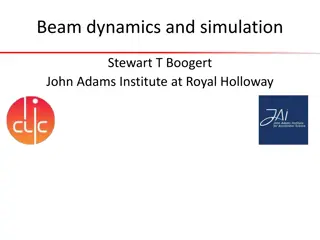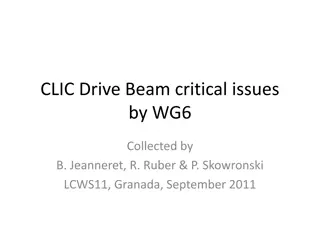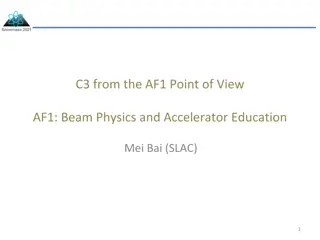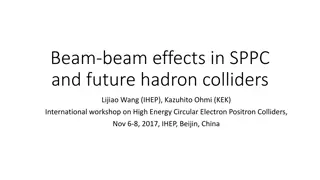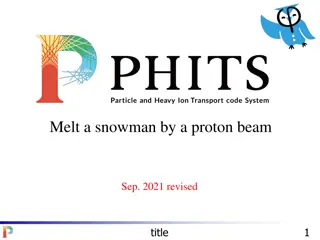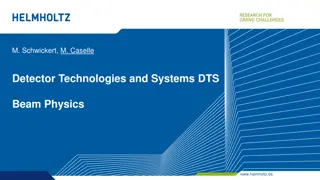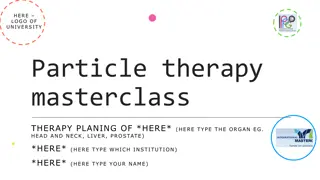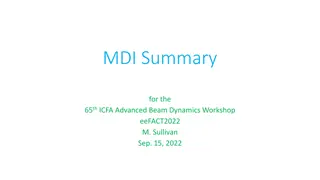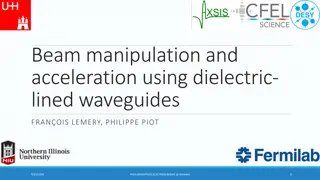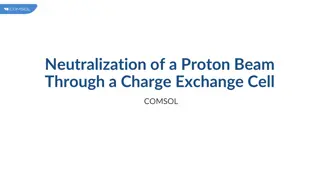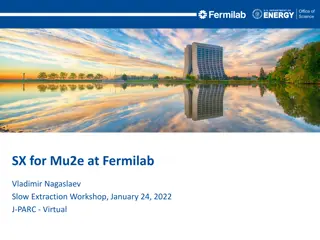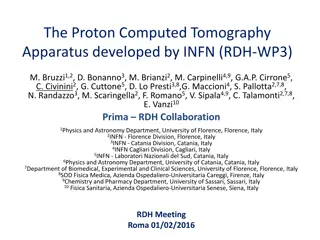Nonlinear Proton Dynamics in the IOTA Ring: Advancements in Beam Acceleration
Probing the frontier of proton acceleration, this research delves into nonlinear dynamics within the IOTA ring, showcasing integrable optics and innovative technologies. Collaborations with Fermilab drive advancements in accelerator science, supported by the US DOE. The study explores variational aspects, chromaticity corrections, and space charge effects, aiming to enhance beam dynamics and energy output in proton accelerators.
Download Presentation

Please find below an Image/Link to download the presentation.
The content on the website is provided AS IS for your information and personal use only. It may not be sold, licensed, or shared on other websites without obtaining consent from the author.If you encounter any issues during the download, it is possible that the publisher has removed the file from their server.
You are allowed to download the files provided on this website for personal or commercial use, subject to the condition that they are used lawfully. All files are the property of their respective owners.
The content on the website is provided AS IS for your information and personal use only. It may not be sold, licensed, or shared on other websites without obtaining consent from the author.
E N D
Presentation Transcript
Nonlinear proton dynamics in the IOTA ring Nathan Cook RadiaSoft, LLC., Boulder, CO ncook@radiasoft.net November 12, 2015 Proton Accelerators for Science and Innovation Fermi National Accelerator Laboratory This work is supported the US DOE Office of Science, Office of High Energy Physics: DE-SC0011340. Boulder, Colorado USA www.radiasoft.net
Collaboration DOE HEP Phase II SBIR project Ongoing collaboration between RadiaSoft and Fermilab D.L. Bruhwiler&N. Cook&S. Webb& R. Nagler& R. Kishek&, A. Valishev# S. Nagaitsev# E. Prebys# & # This work is supported the US DOE Office of Science, Office of High Energy Physics: DE-SC0011340. 2 /21
Outline Integrable optics at IOTA Synergia 2.1 for beam dynamics simulations Nonlinear dynamics in the zero current limit Higher order terms in the nonlinear Hamiltonian Variation with H0 and emittance Correlations between 1st and 2nd invariant Chromaticity correction schemes Initial studies of nonlinear dynamics with space charge Tune depression Diffusive dynamics and phase space mixing 3 /21
Integrable Optics and the IOTA lattice Experimental initiative to test nonlinear integrable optics Danilov & Nagaitsev Nonlinear accelerator lattices with one and two analytic invariants, PRSTAB 13, 084002 (2010) Use of special nonlinear magnet can result in a 2nd invariant of motion, completely integrable dynamics Single particle trajectories are regular and bounded Mitigate parametric resonances via nonlinear decoherence A. Valishev, IOTA - A Brief Parametric Profile, presented at Focused Workshop on Scientific Opportunities in IOTA (Batavia, April, 2015); http://asta.fnal.gov/IOTA/IOTAmeeting/IOTA_S hort.pdf 4 /21
Bunch matching with the nonlinear lattice Danilov & Nagaitsev derived potential which produces Hamiltonian with two analytic invariants Vary magnetic field strengths to obtain order unity tune spread Symmetric motion through NL section preserves integrability A generalized K-V distribution with fixed H demonstrates shape 5 /21
Beam dynamics with space charge via Synergia 2.1 James Amundson, Qiming Lu, Alexandru Macridin, Leo Michelotti, Chong Shik Park, (Panagiotis Spentzouris), Eric Stern and Timofey Zolkin Accelerator Simulation Group Computer time from INCITE Funded by DOE Slide courtesy of James Amundson | Advancing Particle Accelerator Science with High Performance Computing 11/12/15 6 /#
Synergia 2.1 Overview Capabilities include: symplectic tracking for single particle dynamics PIC (validated with GSI space charge benchmark) dynamic lattice element adjustments Fit tunes or chromaticities to desired values Construct arbitrary 6x6 matrix elements New capabilities added by RadiaSoft: bunch matching with arbitrary distributions interactive simulations with an IPython notebook Thanks very much to the Synergia development team, from the Accelerator Simulation group within Fermilab s Scientific Computing Division! Especially: J. Admundson, E. Stern, C.S. Park, L. Michellotti, and P. Spentzouris 7 /21
Initial simulations - 100k turns with NL element Tracking matched proton bunch in lattice Generalized KV distribution with fixed H0 ?x = 0.03 mm-mrad normalized emittance ? = 0% no variation in particle energy Resulting variation is consistent over 100k turns ?H = 1.07%, ?I = 2.56% for the particle shown below Periodic variation which appears bounded 8 /21
Higher order terms in the Nonlinear Hamiltonian Original analysis computed the single turn map for the ideal integrable optics lattice Expansion of the Hamiltonian lowest order correction to H in ?0, the tune-advance through the nonlinear drift The leading order correction to the ideal Hamiltonian H0 scales with ?03, thus implying a variation in H from the first order estimate H0 9 /21
Variation in the first invariant - H0 Simulated a toy-model IOTA lattice, comprised of a nonlinear element followed by a corresponding 6x6 matrix representing a thin double-focusing lens. Variations of the nonlinear element with different ?0 are calculated using a MADX script 10 /21
Variation in H0 with increasing emittance Greater variation in H0 with increasing emittance coefficients in the expansion of the Hamiltonian vary with ?3. Ex. For a NL segment with ?0 =0.3, a KV distribution with H0 = 10 mm-mrad demonstrates an average r.m.s. variation of 5% in calculated value of of H0. 11 /21
Higher order correlations between H and I Turn by turn variation observed over many turns Variations appear bounded and well behaved Suggestive of some surface relating to a new invariant Can we calculate this hyper-surface? 12 /21
Chromatic Considerations in IOTA Tests performed for matched bunches with energy deviations ? 0.5%, with and without chromaticity correction Simulations of chromaticity corrected lattice Beam loss observed (4%) even for a bunch with ? = 0.1% and a normalized emittance of ?x = 0.03 mm-mrad Invariant clearly not preserved - ?H > 15% As ? approaches 0.4%, the majority of the beam is lost Uncorrected lattice retains better single particle dynamics For ? = 0.1%, no particle loss and ?H 10% Conclusion: Off-energy particles in IOTA are more sensitive to sextupole fields than to natural chromaticity of the lattice. 13 /21
Chromaticity Correction Schemes For realistic energy spreads, chromaticity significantly perturbs integrable motion Recent work by Webb et al. presents a chromaticity correction scheme which preserves integrability Require equal horizontal and vertical chromaticities Cx = Cy Sextupoles must be optically transparent (? = (2n +1)? ) Recover normalized Hamiltonian with adjustment to nonlinear strength parameter, t Complete correction may not be needed! Carefully placed sextuples at low strength may correct for energy spread Current work aimed at adjusting IOTA-1IO design to meet these requirements for basic testing 14 /21
Initial simulations with space charge Lattice Parameters: Iota v6.6 lattice with a single NL magnet zero sextupole strength, zero RF CHEF propagation of all lattice elements, 4 slices per element Nonlinear strength parameter t = 0.4 Nonlinear aperture parameter c = 0.01 m1/2 diagnostics at center of NL magnet Space Charge parameters: 2D open solver with 64x64 mesh, periodic in z 100 particles per cell Proton beam parameters: 2.5 MeV protons, matched at center of NL element dp/p = 0, to minimize chromatic effects generalized KV distribution with first invariant H0= 9.74 mm-mrad corresponds to ?x,n = 0.3 mm-mrad, and ?y,n = 0.6 mm-mrad 15 /21
Space charge tune shift in IOTA Linear lattice with zero current tunes are equal and vary weakly with amplitude Qx = Qy = 0.3 Nonlinear lattice with zero current tunes are asymmetric and vary strongly with amplitude Qx = 0.403 Qy = 0.232 (very near the axis) With space charge, tune varies orbit to orbit Compute incoherent tune shift Compare against single particle orbits Observe dQx ~ dQy (near axis) evidence of strong coupling in x and y 16 /21
Particle dynamics - Equilibration and diffusion Mixing on the scale of 1 turn t = 0.4 is rather large, so tune spread leads to fast mixing Diffusion varies with H0 consistent at median values strong tails at large H0 18 /21
Conclusions Simulated IOTA lattice with segmented NL element Invariants appear well behaved over 1 million turns Higher order contributions of NL magnet at zero current Variation in the invariants scales with ?03 and ?3 Large energy spread breaks integrability Dynamics are especially sensitive to sextupole fields Initial simulations with space charge Tune depression appears to break integrability But there may be other nearby invariants Look for bounded behavior to retain nonlinear decoherence Operation at modest currents will likely require adjustments to the magnets surrounding the integrable optics insert 20 /21
Future Work Understand dynamics with space charge Investigate single particle dynamics with low nonlinearity Adjust lattice incrementally to recover integrability Calculate diffusion coefficient in perturbative regime Implement chromaticity correction scheme Optically transparent sextuples to equate chromaticities Optimize dynamic aperture Simulate wakefields in IOTA Quadrupolar term along vertical axis may limit peak current Simulate injection of matched beam Consider machine perturbations misalignments and mismatches 21 /21
